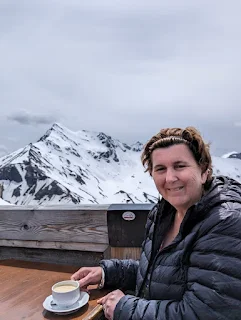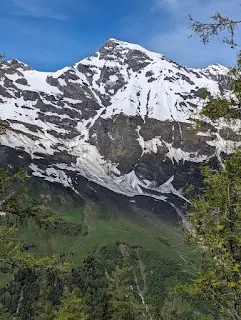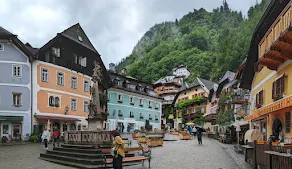After a mammoth day behind the wheel yesterday we thought stay closer to home. Also, the Golf was due to be returned by 4:30pm. Good plan, no? The day was wet and dull when we set off bound for Germany. Yes, Germany. Salzburg is tucked in a little corner of Austria not 10 minutes from its border with Germany. Our plan was to drive via Bad Reichenhall(Germany), Schneizlreuth(Germany), Lofer(Austria), Saalfelden(Austria), Bischofshofen(Austria), Werfen(Austria) and back to Salzburg.
Werfen is the town where my favourite Alaistar MacLean novel “Where Eagles Dare” is set. Rising 110m over the northern end of town is the imposing Burg Hohenwerfen. The fortress is very similar to the Hohensalzburg fortress in Salzburg having been constructed in the same era (early 2nd millennium) by the Prince-Archbishops as part of a defensive and controlling network of fortresses in the region. Werfen is just 40 minutes drive to the south of Salzburg, usually, but roadworks were underway on the A10 autobahn which passes directly by the town. We’d been caught up in the roadworks yesterday and seen them from the other side of the road the day before so didn’t fancy spending an extensive amount of time sitting on a road and going nowhere. So, I dreamed up an alternative route which came in the back way from the south, skirting around the very high peaks. The route was necessarily a large anti-clockwise circumnavigation through the limestone mountains that prevail in that area to the south-west of Salzburg. There are no roads across the highest peaks, a feat too difficult for even the best Austrian engineers, only the roads around them. Our “forty minute” drive to Werfen was going to three times that.
But that didn’t matter because, once again, the scenery was spectacular. Snow-covered peaks soared sharply into the clearing sky high above quaint villages with oh-so-typical Austrian/German houses and public buildings lining the streets. Out of the towns the lush green fields crept up the mountain-sides until they reached the pine forests that eventually had to give-in to the sheer rock walls. Idyllic! Everything you would hope to see in this part of the world. We stopped in the town of Lofer for a wander around town and a coffee and cake for morning tea. The incredible scenery just rolled on and on as we continued our circumnavigation. Low-key, family-oriented skiing is a big part of this region in the winter months. None of your big, bad slopes here, just places where the kids can have fun and learn to ski. Guesthouses to accommodate the visitors abound. The last 40 minutes from Maria Alm to Bischofshofen was particularly challenging for the driver. First up a wet, winding mountain road then down the other side and then along the Muhlbach following every one of its twists and turns. I was glad when we reached Bischofshofen. I wasn’t glad when GPS-man eschewed the back road into Werfen in favour of the A10 and its roadworks because it was a few hundred metres shorter to go that way!! The roadworks weren’t anywhere near as bad as those that were stopping the traffic coming from the north but bad enough, coupled with our now significantly diminished time budget due to the longer than anticipated drive around the high peaks, to dispense with a visit to Burg Hohenwerfen. We stopped in Werfen long enough to get a photo of the castle from the train station and then moved on. The A10 could not be entered from Werfen so all the traffic bound for Salzburg was diverted through a stunning, narrow chasm between two mountains. The chasm has been cut by the river Salzach on its way to Salzburg. We eventually made it back to Salzburg and dripped the car off just before 2:30pm.
I learned after the fact that many of the town scenes in “Where Eagles Dare” were filmed in Lofer, which we had stopped at earlier in the day. Other scenes were filmed in the Salzkammergut where we’d been yesterday. If you ever get to see this landscape you will understand why the title of Alistair MacLean’s novel is so apt.
The bus back into town passed a temporary market outside the Mirabell Palace so we got off to explore. It was mid-afternoon and we’d had little to eat all day so we grabbed a couple of breads from the Italian-themed market and found a shady seat in the Palace gardens to eat and enjoy the gardens once again. By now the sky was sunny and blue making the Hohensalzburg Fortress in the distance look better than ever. Since we were so close, a photograph on the famous “Do, Re, Mi” steps in the garden was a must. Back along the Salzach we strolled to the No. 28 bus and home to prepare for our long train journey tomorrow.























































